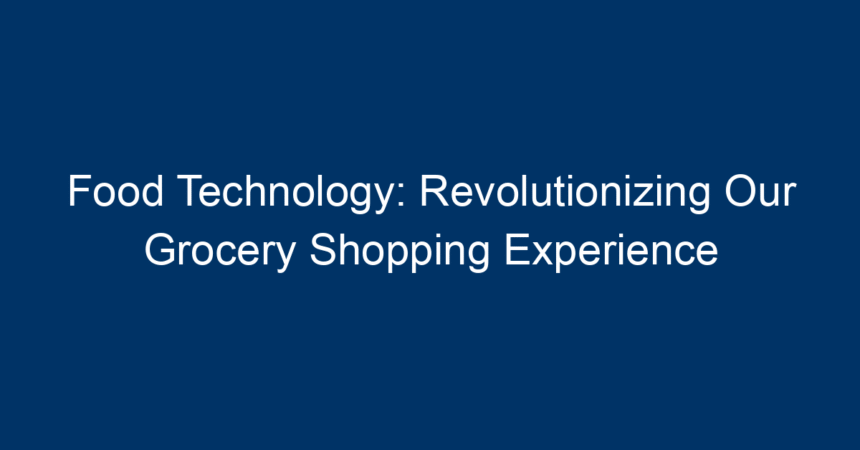In a world dominated by rapid technological advancement, food technology stands at the forefront, reshaping how we approach our grocery shopping experience. From smart fridges that track inventory to apps that suggest the best recipes based on what’s in your pantry, innovations in food technology are not just making our lives easier; they are redefining the way we consume and interact with food. In this article, we’ll delve into the exciting ways food technology is transforming grocery shopping, enhance our understanding of its benefits, and look ahead to what the future holds.
The Emergence of Food Technology
Food technology refers to the application of science and technology in the production, processing, preservation, and distribution of food. Over the years, this field has grown exponentially. Innovations in food technology are not only aimed at enhancing the quality and safety of food but also at improving sustainability, nutrition, and convenience in our everyday lives.
Influence of Food Technology on Consumer Behavior
As consumers become more health-conscious and environmentally aware, food technology is playing a critical role in influencing how they shop. Enhanced access to information via QR codes, smart labels, and mobile applications empowers consumers to make informed choices. Here’s a look at some of the key advancements:
1. Smart Shopping Assistants
Smart shopping assistants, powered by artificial intelligence (AI), are leading the way in streamlining grocery shopping. These technologies can analyze your purchase history and preferences to generate personalized shopping lists and suggest healthier alternatives. Imagine walking into a store, and a mobile app notifies you of ongoing sales on your favorite items, or even suggests recipes based on what’s available. This convenience not only saves time but also enhances dietary choices.
2. Online Grocery Shopping
The rise of e-commerce has transformed how we shop for groceries. With food technology at its core, services like Instacart, Amazon Fresh, and Walmart’s online grocery delivery are making it easy for consumers to order groceries from the comfort of their homes. Personalized recommendations, customer reviews, and detailed nutritional information have all contributed to a seamless online shopping experience.
3. Augmented Reality (AR) and Virtual Reality (VR)
Emerging technologies in food tech, such as AR and VR, are taking grocery shopping to new heights. Retailers are experimenting with AR applications that allow customers to visualize how grocery items fit into their meals or even their kitchens. This interactive experience enhances customer engagement. Additionally, VR can offer virtual store tours, giving consumers a chance to experience products before making a purchase, thus revolutionizing how they shop.
Enhancing Food Safety through Technology
Food safety is a significant concern for consumers, and technology is stepping up to address these issues.
1. Food Traceability
One of the critical advancements in food technology is improving food traceability. Using blockchain and RFID technologies, consumers can trace the journey of their food from farm to table. This transparency builds trust and allows consumers to make informed decisions about the products they purchase. Knowing where food comes from and how it has been processed enhances consumer confidence and promotes safer eating practices.
2. Smart Packaging
Innovative packaging technology is also evolving to improve food safety. Smart packages equipped with sensors can detect spoilage and provide real-time information about a product’s freshness. This not only helps minimize food waste but also ensures that consumers are consuming safe, high-quality products.
Sustainability in Food Technology
Sustainability is at the heart of food technology advancements. As awareness of food waste and its environmental impact rises, tech solutions are emerging to tackle these challenges.
1. Food Waste Reduction Applications
Numerous applications are utilizing food technology to connect consumers with surplus food options. Platforms like Too Good To Go and Olio enable businesses and consumers to save excess food from being thrown away, redistributing it to those who need it. This not only helps reduce waste but also provides affordable meals to individuals, contributing to community welfare.
2. Vertical Farming and Hydroponics
Vertical farming and hydroponic systems are revolutionizing how we grow food. These technologies allow for food production in urban areas, reducing transportation emissions and providing fresher produce to consumers. By utilizing controlled environments and advanced techniques, we can grow healthy food using less water and land than traditional farming methods.
The Future of Grocery Shopping with Food Technology
As we look ahead, the integration of food technology into grocery shopping will continue to evolve.
1. Biotechnology and Genetic Engineering
Advancements in biotechnology and genetic engineering are enabling the development of crops that are more resistant to pests, diseases, and climate change. These innovations could lead to food that is not only more sustainable but also has enhanced nutritional profiles. As consumers become more aware of the nutritional value of their food, this may drive demand for such products.
2. The Rise of Artificial Intelligence
AI’s role in food technology will undoubtedly expand. From predicting trends to automating inventory management, AI can optimize several facets of grocery shopping. Consumers will likely benefit from ultra-personalized experiences, with AI analyzing data to suggest products specifically tailored to health goals, dietary restrictions, and taste preferences.
Conclusion: Embracing the Change
The impact of food technology on grocery shopping is profound and multifaceted, offering enhanced convenience, safety, and sustainability. As innovations continue to emerge, consumers have the opportunity to make more informed choices that align with their health and environmental values.
To embrace these changes, consider the following actionable insights:
-
Stay Informed: Keep up with trends in food technology and actively explore apps and tools that can enhance your grocery shopping experience.
-
Adopt E-Commerce Solutions: Embrace online grocery shopping options that utilize advanced technology for convenience and personalized service.
- Support Sustainable Practices: Choose brands and retailers that prioritize sustainability and transparency in their food sourcing.
In a rapidly changing world, food technology is not just a tool for convenience but a vital component in creating a healthier, more sustainable future for our society and our planet. Embrace these changes, and let technology revolutionize your grocery shopping experience!




